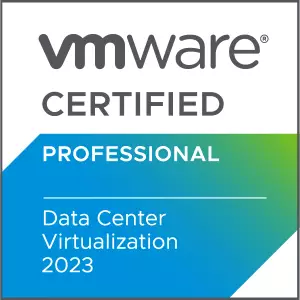Certificazione VCP-DCV 2023
 La Certificazione VMware Certified Professional - Data Center Virtualization 2023 convalida competenze tecniche nell'installazione, configurazione e gestione di un ambiente VMware vSphere 8.0 di qualsiasi dimensione, nonchè specifiche capacità nell'effettuare operazioni di troubleshooting e attività di monitoraggio di base su un'installazione vSphere
La Certificazione VMware Certified Professional - Data Center Virtualization 2023 convalida competenze tecniche nell'installazione, configurazione e gestione di un ambiente VMware vSphere 8.0 di qualsiasi dimensione, nonchè specifiche capacità nell'effettuare operazioni di troubleshooting e attività di monitoraggio di base su un'installazione vSphere
Come ottenere la certificazione VCP-DCV 2023
Per conseguire la certificazione VCP-DCV 2023 è necessario superarare l'esame Professional VMware vSphere 2V0-21.23.
corso vSphere VCP-DCV 2023 v8.0
Per sostenere l'esame 2V0-21.23 è obbligatorio frequentare un corso di formazione ufficiale autorizzato VMware come quello proposto da IpCert
Caratteristiche esame 2V0-21.23
- Durata: 135 minuti
- Quesiti: 70
- Lingua: Inglese
- Prerequisiti: Nessuno
Validità e Rinnovo
Validità: Nessuna scadenza
Rinnovo: A partire da febbraio 2019 la certificazione VMware non prevede più la necessità di rinnovo
Argomenti d'esame 2V0-21.23
Section 1: Architectures and Technologies- Identify the pre-requisites and components for a VMware vSphere 8.x implementation
- Describe the components and topology of a VMware vCenter architecture
- Describe storage concepts
- Describe VMware ESXi cluster concepts
- Explain the difference between VMware standard switches and distributed switches
- Describe VMware vSphere Lifecycle Manager concepts
- Describe the basics of VMware vSAN as primary storage
- Describe the role of Virtual Machine Encryption in a data center
- Recognize methods of securing virtual machines
- Describe identity federation
- Describe VMware vSphere Distributed Services Engine
- Identify use cases for VMware Tools
- Describe the high-level components of VMware vSphere with Tanzu
Section 2: VMware Products and Solution
- Describe the role of VMware vSphere in the Software-Defined Data Center
- Identify use cases for VMware vSphere+
- Identify use cases for VMware vCenter Converter
- Identify disaster recovery (DR) use cases
Section 3: Planning and Designing
Section 4: Installing, Configuring, and Setup
- Describe single sign-on (SSO)
- Configure vSphere distributed switches
- Configure Virtual Standard Switch (VSS) advanced virtual networking options
- Set up identity sources
- Deploy and configure VMware vCenter Server Appliance (VCSA)
- Create and configure VMware HA and DRS advanced options (Admission Control, Proactive HA, etc.)
- Deploy and configure VMware vCenter High Availability
- Set up content library
- Subscribe to content library
- Manage virtual machine (VM) template versions
- Configure VMware vCenter file-based backup
- Configure vSphere Trust Authority
- Configure vSphere certificates
- Configure vSphere Lifecycle Manager
- Configure different network stacks
- Configure host profiles
- Identify ESXi boot options
- Deploy and configure clusters using the vSphere Cluster Quickstart workflow
- Set up and configure VMware ESXi
- Configure VMware vSphere with Tanzu
Section 5: Performance-tuning, Optimization, Upgrades
- Identify resource pools use cases
- Monitor resources of a VMware vCenter Server Appliance (VCSA) and vSphere 8.x environment
- Identify and use resource monitoring tools
- Configure Network I/O Control (NIOC)
- Configure Storage I/O Control (SIOC)
- Configure a virtual machine port group to be offloaded to a data processing unit (DPU)
- Explain the performance impact of maintaining virtual machine snapshots
- Use Update Planner to identify opportunities to update VMware vCenter
- Use vSphere Lifecycle Manager to determine the need for upgrades and updates
- Use performance charts to monitor performance
- Perform proactive management with VMware Skyline
- Use VMware vCenter management interface to update VMware vCenter
- Complete lifecycle activities for VMware vSphere with Tanzu
Section 6: Troubleshooting and Repairing
- Identify use cases for enabling vSphere Cluster Services (vCLS) retreat mode
- Differentiate between the main management services in VMware ESXi and vCenter and their corresponding log files
- Generate a log bundle
Section 7: Administrative and Operational Tasks
- Create and manage virtual machine snapshots
- Create virtual machines using different methods (Open Virtualization Format (OVF) templates, content library, etc.)
- Manage virtual machines (modifying virtual machine settings, VMware per-VM EVC, latency sensitivity, CPU affinity, etc.)
- Manage storage
- Create DRS affinity and anti-affinity rules for common use cases
- Migrate virtual machines
- Configure role-based access control
- Manage host profiles
- Utilize VMware vSphere Lifecycle Manager
- Use predefined alarms in VMware vCenter
- Create custom alarms
- Deploy an encrypted virtual machine
La lista qui riportata fornisce un'indicazione generale degli argomenti affrontati nell'esame. Si ricorda tuttavia per motivi di trasparenza che tale elenco potrebbe essere modificato da VMware in qualunque momento e senza preavviso alcuno.
Link risorsa ufficiale (VCP-DCV 2023 su vmware.com)
Panoramica generale Certificazioni VMware

